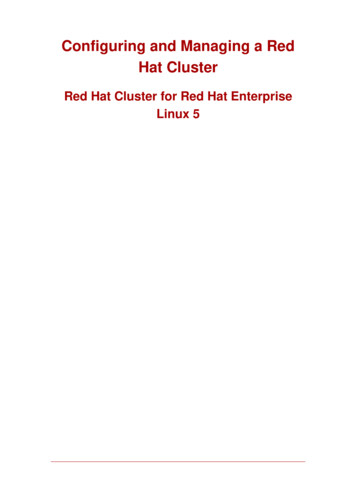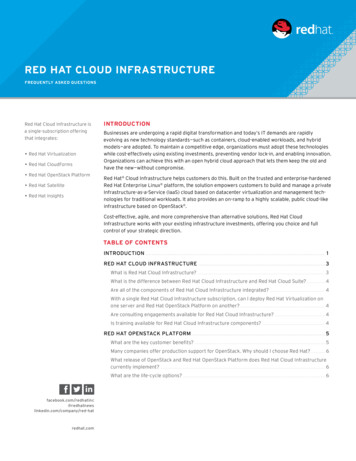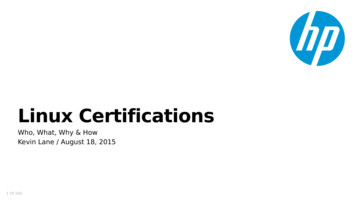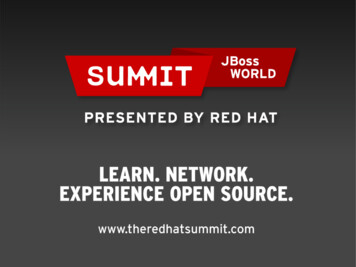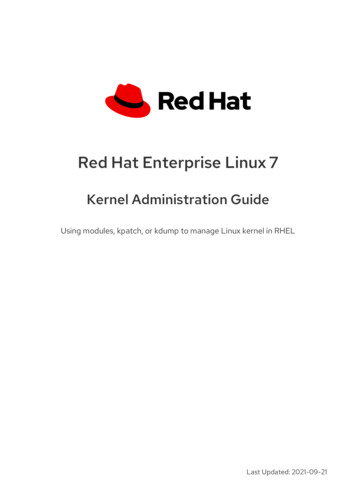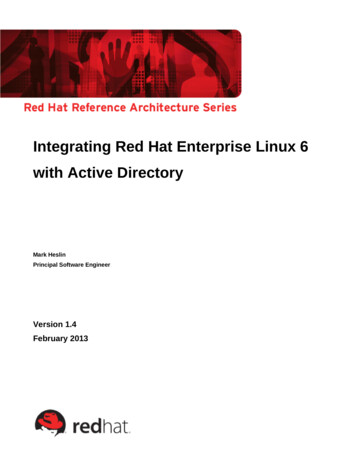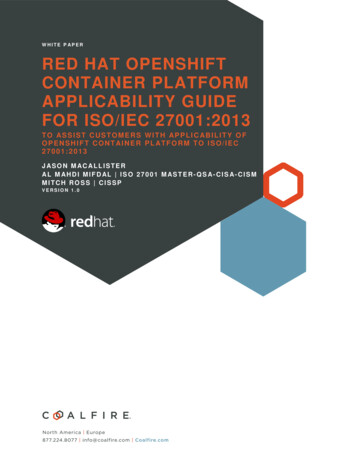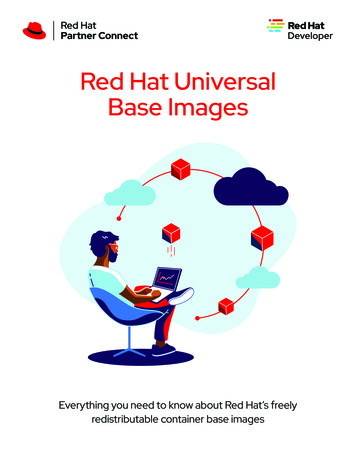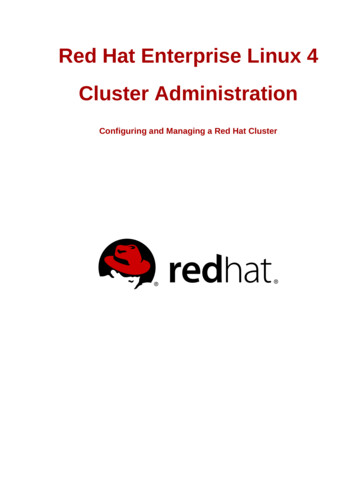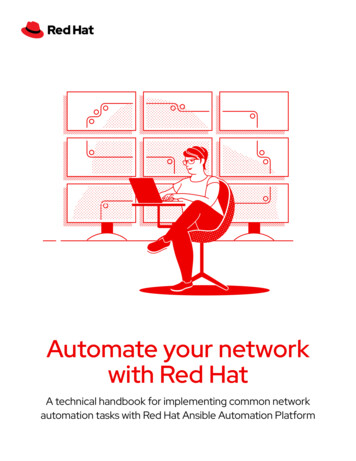
Transcription
Automate your networkwith Red HatA technical handbook for implementing common networkautomation tasks with Red Hat Ansible Automation Platform
Chapter 1Chapter 2Chapter 3Chapter 4Chapter 5See what’s insideSpeed operations with network automationChapter 1Install and configure Red Hat Ansible Automation PlatformChapter 2Run your first command and playbookChapter 3Build your inventoryChapter 4Implement common use casesChapter 5Access content to use with Red Hat Ansible Automation PlatformFind more informationReady to get started?Automate your network with Red Hat Contents
Chapter 1Chapter 2Chapter 3Chapter 4Chapter 5Speed operations with network automationTraditional, manual approaches to network configuration and updates are too slow anderror-prone to effectively support today’s rapidly shifting application and data transferrequirements. Programmable, software-based automation technologies can help yourteam better support your organization’s digital initiatives.With network automation, network operations (NetOps) teams can quickly respondto dynamic needs for capacity, application security, load balancing, and multicloudintegrations. They can also implement self-service and on-demand network activities.As a result, NetOps teams can become as agile and flexible as applications and infrastructure teams to support modern business demands.Key resourcesCheck out these resources to learnthe basics of Red Hat AnsibleAutomation Platform: Online training:Ansible Essentials E-book:Network automation for everyoneSpeed operations with Red Hat Ansible Automation PlatformWith Red Hat Ansible Automation Platform, Red Hat brings the popular community Ansible project to the enterprise, adding the features and functionality neededfor team-based automation at scale. This powerful IT automation platform combinesa simple, easy-to-read automation language with a trusted, composable executionenvironment and security-focused sharing and collaboration capabilities. Becauseprogramming skills are not required, roles across your organization can readily useAnsible Automation Platform.Ansible Automation Platform helps you streamline and manage complex datacenterenvironments, from servers and networks to applications and DevOps. It providessupport for legacy and open network infrastructure devices across multivendor virtualand physical environments so you can automate your entire network using a single tool.This e-book explains how to get started with common network automation tasks.NOTE: The commands in this e-book are written for Ansible Automation Platform 1.xand are not applicable for Ansible Automation Platform 2.0 and later.Automate your network with Red Hat 1
Chapter 1Chapter 2Chapter 3Chapter 4Chapter 5Install and configure Red HatAnsible Automation PlatformInstall Red Hat Ansible Automation PlatformInstalling and setting up Red Hat Ansible Automation Platform is easy and fast.Step1aInstall command-line Ansible using yumRun the following command: sudo yum install ansibleRead the Ansible installation guide for complete instructions.Step1bInstall Ansible Automation Platform using the installation tool1. Make sure you have the latest edition or download a free trial at red.ht/try ansible.2. Unpack the tar file (version and name may be different): tar xvzf ar.gz3. Set up your passwords: admin password for administration rabbitmq password for messaging pg password for database4. Run the setup script. Once installation has completed, navigate to your Ansible Automation Platform host usingGoogle Chrome or Mozilla Firefox by using either the hostname or IP address.Read the Ansible Automation Platform quick installation guide for complete instructions.Step2Install Ansible Automation Platform Content Collections for networkingRed Hat offers certified, supported Content Collections for a wide variety of network devices, tools, and infrastructure through Ansible Automation Hub. Each Collection exists within a namespace that contains one or more Collections. Use the ansible-galaxy command to install these Collections: ansible-galaxy collection install namespace.collection nameFollow the instructions in the Red Hat Ansible Automation Platform documentation to configure Ansible Automation Hub to access and manage your Collections. You can find community-supported Collections on Ansible Galaxy.Automate your network with Red Hat 2
Chapter 1Chapter 2Chapter 3Chapter 4Chapter 5Set up your network environmentWe recommend you configure your network environment for Red Hat Ansible Automation Platform according to these best practices.Ensure connectivity to your network environmentInstall an Ansible Automation Platform service account on your routers and switches for login and authentication. Ansible Automation Platform supports enterprise authentication methods like Terminal Access ControllerAccess-Control System Plus (TACACS ) and Remote Access Dial-In User Service (RADIUS). Learn more in theSetting up enterprise authentication section of the documentation.Create your playbook repositoryConnect Ansible Automation Platform to your Source Control Management (SCM) tool by setting up a projectin the web interface, giving you access to all playbooks in that project repository.Configure your inventoryCreate an inventory of the network devices you want to automate. Ansible Automation Platform can manage multiple inventories. You can dynamically load inventories from popular tools like Amazon Web Services EC2, MicrosoftAzure Resource Center, and VMware vCenter using inventory plugins. You can also load inventories from an AnsibleAutomation Platform project. Chapter 3 of this e-book describes more about building and using inventories.Set your network firewall rulesSet your firewall rules to allow Ansible Automation Platform to connect to routers and switches using the defaultSecure Shell (SSH) port 22. If desired, you can change this port number using the ansible port host variable.Set your Ansible Automation Platform passwordsCreate a credential for holding your passwords. You can grant users and teams the ability to use credentials withoutactually exposing the credential to the user.Create an Ansible job templateCreate a job template to connect your inventory, credential, and project. Job templates define sets of parametersfor running automation jobs, allowing you to execute the same set of tasks many times and reuse content acrossteams. Each job template includes: A project from which to load Ansible playbooks. An inventory or list of automation targets like network switches. A credential for logging into and automating the devices in your inventory.Automate your network with Red Hat 3
Chapter 1Chapter 2Chapter 3Chapter 4Chapter 5Run your first command and playbookGet to know playbooksPlaybooks are Ansible’s configuration, deployment, and orchestration language. They consist of sets of human-readable instructionscalled plays that define automation across an inventory of hosts. Each play includes one or more tasks that target one, many, or all hostsin an inventory. Each task calls an Ansible module that performs a specific function like collecting useful information, backing up networkfiles, managing network configurations, or validating connectivity.Playbooks can be shared and reused by multiple teams to create repeatable ality assuranceAutomate your network with Red Hat 4ProductionOperationsManagementOutsourcers
Chapter 1Chapter 2Chapter 3Chapter 4Chapter 5Anatomy of a playbookThis example shows the common parts of an Ansible playbook.12345678910111213141516171819--- name: add vlanshosts: aristagather facts: falseIndicates the start of a playbookCalls a device or group of devices named aristaOptional parameter for retrieving factsvars:vlans:- name: desktopsvlan id: 20- name: serversvlan id: 30- name: DMZvlan id: 50Variable definitiontasks:- name: add VLAN configurationarista.eos.eos vlans:state: mergedconfig: “{{ vlans }}”Learn more about surveys in the Create a Red HatAnsible survey section on page 6.Automate your network with Red Hat 5In this playbook, we define variable values directly.If you are using the Red Hat Ansible AutomationPlatform web interface, you can also create asurvey to prompt users for variable values whenthey run your playbook. In that case, replace lines9, 11, and 13 with:# {{variable name}} inputTasksTasks and Ansible modules have a 1:1 correlation.This section calls modules to configure virtuallocal area networks (VLANs) for each of the threevariables defined in the vars section.
Chapter 1Chapter 2Chapter 3Chapter 4Chapter 5Create a Red Hat Ansible surveySurveys set extra variables for your playbook in a user-friendly question-and-answer way. To create a survey:1. Click the Add survey button in the Red Hat Ansible Automation Platform web interface.2. For each question fill out the following information: Name: The question to ask the user Description (optional): A description of what is being asked Answer variable name: The Ansible variable name in which the response will be stored Answer type: The format — entered text, multiple choice, or number — of the response Default answer: The default value of the variable Required: Whether or not the question is optional3. Click the button to add the question to the survey.4. Repeat step 3 to add more questions to the survey.5. Click the Save button to save the survey when you are finished.Read the Surveys section of the Ansible Automation Platform documentation to learn more.Run your playbookRunning a playbook is simple, but the process is different for command-line Ansible and the Ansible Automation Platform web interface.Command-line AnsibleRun the following command:ansible-playbook playbook name -i inventory file Red Hat Ansible Automation Platform web interfacePress the launch job (rocket) button next to your template in the Ansible Automation platform web interface.Automate your network with Red Hat 6
Chapter 1Chapter 2Chapter 3Chapter 4Chapter 5Build your inventoryUnderstand inventoriesAn inventory is a collection of hosts that may be acted on using Ansible commands and playbooks. Inventory files organize hosts intogroups and can serve as a source of trust for your network. These files can be formatted as simple INI or YAML. Many organizationschoose to write their inventories in YAML for consistency with their playbooks. Using an inventory file, a single playbook can maintainhundreds of network devices with a single command.This chapter explains how to build an inventory file.Create a basic INI-formatted inventoryFirst, group your inventory logically. Best practices are to group servers and networkdevices by their what (application, stack, or microservice), where (datacenter orregion), and when (development stage). What: db, web, leaf, spine Where: east, west, floor 19, building A When: dev, test, staging, prodThis example code, in INI format, illustrates a basic group structure for a very smalldatacenter. You can group groups using the syntax [metagroupname:children]and listing groups as members of the metagroup.Here, the group network includes all leafs and all spines. The group datacenterincludes all network devices plus all webservers.Read the Build your inventory section of the Ansible documentation to learn more.You can also find a sample inventory report playbook on GitHub.Automate your network with Red Hat dren]networkwebservers
Chapter 1Chapter 2Chapter 3Chapter 4Chapter 5Anatomy of a YAML-formatted 26272829303132333435363738--all:vars:ansible user: adminansible password: password123ansible become pass: password123ansible become: Trueansible become method: enableansible network cli ssh type: er:arista:hosts:rtr2:ansible host: 172.16.100.2rtr4:ansible host: 172.16.100.4vars:ansible network os: arista.eos.eosansible connection: ansible.netcommon.network clicisco:hosts:rtr1:ansible host: 172.16.100.1vars:ansible network os: cisco.ios.iosansible connection: ansible.netcommon.network clijuniper:hosts:rtr3:ansible host: 172.16.100.3vars:ansible network os: junipernetworks.junos.junosansible connection: ansible.netcommon.netconfAutomate your network with Red Hat 8Indicates the start of a playbookDefines variables that apply toall hosts within the inventory,regardless of groupGroup hierarchyLines 10-15 identify the hostgroups within this inventory.In this case, the group routerscontains three subgroups:arista, cisco, and juniper.Group definitionThe hosts command defineswhich hosts belong to eachgroup. In this example, the grouparista contains two hosts thatare identified by IP address.Group variablesEach group can have its ownset of variables. This inventorydefines the operating systemand connection type for eachgroup. Both of these variablespoint to items contained incontent collections.Learn more about thesevariables in the Group yourvariables section on page 10.
Chapter 1Chapter 2Chapter 3Chapter 4Chapter 5Group inventory by platformAs your inventory grows, you may want to group devices by platform so you can easily define platform-specific variables for all deviceson that platform. Lines 10-15 of the example inventory identify the hierarchy of host groups for this inventory. The routers groupcontains three children or subgroups categorized by platform: arista, cisco, and juniper. Each of these subgroups contains oneor more hosts, defined by IP address in lines 16-21, 25-28, and le host: 172.16.100.2rtr4:ansible host: 172.16.100.4Read the Group inventory by platform section of the Ansible documentation to learn more.Automate your network with Red Hat 9
Chapter 1Chapter 2Chapter 3Chapter 4Chapter 5Set your variablesYou can set values for many of the variables you needed in your first Ansible command in the inventory, so you can skip them in theansible-playbook command. Lines 2-9 of the example inventory define variables that apply to all hosts listed in the inventory,regardless of which group they belong to.23456789all:vars:ansible user: adminansible password: password123ansible become pass: password123ansible become: Trueansible become method: enableansible network cli ssh type: libsshYou can set and store variables in several different files. As a best practice, set variables used to connect to devices — like logininformation or IP address — in inventory files or playbooks. Set variables related to device configuration in separate files storedin the group vars directory. Read the Organizing host and group variables section of the Ansible documentation to learn more.Group your variablesWhen devices in a group share the same variable values, like operating system (OS) or SSH user, you can reduce duplication andsimplify maintenance by consolidating these into group variables. Group variables are set within their respective group definitions.Lines 22-24, 29-31, and 36-38 of the example inventory set group variable values for each of the three host groups.222324vars:ansible network os: arista.eos.eosansible connection: ansible.netcommon.network cliThis example defies network operating system (NOS) and connection type variables for each of the three subgroups. In this case, thesevariables point to items contained in Red Hat Ansible Automation Platform Content Collections. Content Collection items are formatted as namespace.collection name.item. For example, arista.eos.eos points to the EOS operating system plugin within theEOS Collection delivered through the Arista namespace, while ansible.netcommon.network cli points to the network CLI pluginwithin the Netcommon Collection delivered through the Ansible namespace.Automate your network with Red Hat 10
Chapter 1Chapter 2Chapter 3Chapter 4Chapter 5Variable syntaxThe syntax for variable values is different in inventory, in playbooks, and in group vars files. Even though playbook and group vars filesare both written in YAML, you use variables differently in each.INI-style inventory filesUse the syntax key value for variable values:ansible network os cisco.ios.iosFiles with .YML and .YAML extensionsUse YAML syntax:key: valueGroup vars and playbook filesUse the full key name:ansible network os: cisco.ios.iosRead the Variable syntax section of the Ansible documentation to learn more.Protect sensitive variablesBest practices are to use additional protection for sensitive variables like passwords.Red Hat Ansible Automation Platform provides credential management for passwords and key information. Using the Credentials pagein the web interface, you can grant users and teams the ability to use credentials without exposing the credential to the user. Read theCredentials section of the Ansible documentation to learn more.Note that Ansible Automation Platform can run on systems with Federal Information Processing Standards (FIPS) mode enabled.Automate your network with Red Hat 11
ChapterChapter 11ChapterChapter 22ChapterChapter 33ChapterChapter 44ChapterChapter 55Implement common use casesThis chapter shows sample playbooks for common network automation use cases.Add a VLANConfiguring VLANs that span multiple network devices is an ongoing activity for NetOps. Ansible makes it easy to create a VLANand propagate it across your network.123456789101112131415161718--- name: add vlanshosts: aristagather facts: falsevars:vlans:- name: desktopsvlan id: 20- name: serversvlan id: 30- name: DMZvlan id: 50tasks:- name: add VLAN configurationarista.eos.eos vlans:state: mergedconfig: “{{ vlans }}”Automate your network with Red Hat 12
Chapter 1Chapter 2Chapter 3Chapter 4Chapter 5Gather factsMost networks contain many different platforms and devices. Ansible can query, store, and report on network data like software versionsand interface information.12345678910111213141516--- name: use facts modulehosts: ciscogather facts: falsetasks:- name: retrieve factscisco.ios.ios facts:- name: display versiondebug:msg: “{{ ansible net version }}”- name: display serial numberdebug:msg: “{{ ansible net serialnum }}”Automate your network with Red Hat 13
Chapter 1Chapter 2Chapter 3Chapter 4Chapter 5Retrieve resource informationAnsible network resource modules simplify and standardize how you manage different network devices. Any resource module can usestate: gathered to retrieve information about network resources.1234567891011121314--- name: retrieve interface informationhosts: ciscogather facts: falsetasks:- name: use state gatheredcisco.ios.ios interfaces:state: gatheredregister: interfaces info- name: print out interfaces informationdebug:msg: “{{ interfaces info }}”Automate your network with Red Hat 14
Chapter 1Chapter 2Chapter 3Chapter 4Chapter 5Back up configurationsStoring backups of configurations is a critical activity for NetOps. Ansible Automation Platform makes it easy to pull parts of or an entireconfiguration from a network device.12345678--- hosts: ciscogather facts: falsetasks:- name: back up configcisco.ios.ios config:backup: yesAutomate your network with Red Hat 15
Chapter 1Chapter 2Chapter 3Chapter 4Chapter 5Access content to use withRed Hat Ansible Automation PlatformYou can access ready-to-use automation content to make adoption of Red Hat Ansible Automation Platform even faster and easier.Ansible Content CollectionsA Content Collection is a standardized distribution format for Ansible content that can include playbook examples,roles, modules, plugins, and more. This new format decouples the Ansible executable from most of the automationcontent, giving you more flexibility and portability. You can install community-supported Collections from AnsibleGalaxy and fully supported, certified Collections from Ansible Automation Hub.Ansible rolesAnsible roles bundle automation content to make it reusable. Instead of creating long playbooks with hundreds oftasks, you can use roles to organize and break tasks apart into smaller, more discrete units of work. A role includesall of the tasks, variables, and handlers needed to complete a unit of work. Roles are distributed either as standaloneentities or as part of Content Collections.Ansible Automation HubAnsible Automation Hub gives Red Hat Ansible Automation Platform subscribers access to fully supported andcertified Content Collections developed, tested, and maintained by Red Hat and its technology partners. It givesyou a secure portal to Content Collections, as well as a private network for internal and third-party automationcontent. Automation Hub is the de-facto repository for content used in production automation environments.Ansible GalaxyAnsible Galaxy houses all community Ansible Collections, as well as existing standalone roles. You can alsocontribute the Collections and roles you create to the community through Ansible Galaxy.Automate your network with Red Hat 16
Chapter 1Chapter 2Chapter 3Chapter 4Chapter 5Find more informationRed Hat provides many resources — including detailed documentation, articles, videos, and discussions — for Red Hat Ansible AutomationPlatform. Most are located at ansible.com and on the Red Hat customer portal. Product website:Red Hat Ansible Network Automation Main repository:Ansible documentation Documentation:Network platform index User guides:Inventories and variablesSurveysCredentials E-book:Network automation for everyone Training classes:Ansible essentialsAnsible for Network Automation Free trial:Red Hat Ansible Automation Platform trial downloadAutomate your network with Red Hat 17
Chapter 1Chapter 2Chapter 3Chapter 4Chapter 5Ready to automate your network?Using an intuitive, human readable language, Red Hat Ansible Automation Platformgives you a simple, powerful path to modern network operations, while supportingyour current processes and existing infrastructure. With a flexible, scalable automationframework, you can improve infrastructure availability, staff productivity, networksecurity, and configuration compliance more easily.Try Red Hat Ansible Automation Platform for free:red.ht/try ansibleDeploy faster with Red Hat experts.Automating your network may seem like a daunting task, but Red Hat Consultingcan help. All Red Hat Consulting engagements begin with a half-day complimentaryon-site discovery session. During these sessions, Red Hat experts work with you toidentify your most pressing business challenges, viable approaches for overcomingthem, and desired outcomes for implementing network automation.Schedule a complimentary discovery session:redhat.com/consultingCopyright 2021 Red Hat, Inc. Red Hat, the Red Hat logo, and Ansible are trademarks or registered trademarks of Red Hat, Inc.or its subsidiaries in the United States and other countries.F28378 0421 KVM
support for legacy and open network infrastructure devices across multivendor virtual and physical environments so you can automate your entire network using a single tool. This e-book explains how to get started with common network automation tasks. NOTE: The commands in this e-book are written for Ansible Automation Platform 1.x
